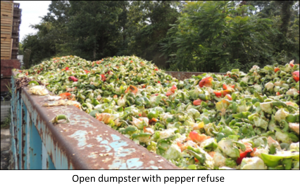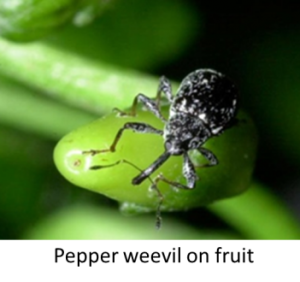Sign up for pepper weevil monitoring with the Rutgers IPM Team. Our base fee is $450 per farm and $100 per trap deployed. If we are already doing insect trapping or field scouting at a farm, then the only additional cost is for the weevil pheromone traps. We suggest that one trap be set in a high traffic area near the packing shed and then at least one trap per field.
For more information or to sign up for weevil monitoring, contact Joe Ingerson-Mahar, phone – 856-889-5718, or email, mahar@aesop.rutgers.edu
For the past two years we have had two NE-SARE grants and a grant from the Charles and Lena Maier Fund, New Jersey Vegetable Growers Association, to study the movement of pepper weevil within New Jersey and how it arrives here. This article summarizes our findings and what the situation is for 2014.
How they get here
 Pepper weevils are brought into the state in peppers that were grown in the southern tier of states, Mexico and other locations of the American tropics. Because of the biology of the weevil, the peppers often do not show external damage and so fruit from heavily infested fields can be picked, packaged and transported to unsuspecting markets. Weevil adults escape into the local environs of the produce handling facility via the dumping of refuse or damaged fruit into open dumpsters.
Pepper weevils are brought into the state in peppers that were grown in the southern tier of states, Mexico and other locations of the American tropics. Because of the biology of the weevil, the peppers often do not show external damage and so fruit from heavily infested fields can be picked, packaged and transported to unsuspecting markets. Weevil adults escape into the local environs of the produce handling facility via the dumping of refuse or damaged fruit into open dumpsters.
If there are no pepper fields nearby or other solanaceous crops, then the presence of weevils is of little consequence. However, in southern New Jersey we have nearly 7,000 acres of food (tomato, potato, eggplant, weeds and peppers) and reproductive hosts (peppers) concentrated in a small area. The number of vegetable farms and their proximity to each other and the movement of produce bins and equipment help the weevils move farm to farm. Pepper weevils are good fliers but it is uncertain how far they can fly. However, flying to adjacent or nearby fields is within their ability. They can be transported on vehicles – a 1930s article noted that a pepper weevil adult was transported on a car’s windshield 15 miles.
Life cycle
 Once the weevils find pepper plants they begin to reproduce, laying eggs singly in flowers or developing fruit. The smaller fruit is usually aborted by the plant, but as fewer developing fruit remain, the more the females will lay eggs in larger fruit which will not be aborted. Their short, three-week life cycle allows for multiple, overlapping generations in our growing season. With each female being capable of laying about 200 eggs in flowers and developing fruit, large populations can develop quickly. Currently registered insecticides are unable to exterminate field infestations. This insect pest should be considered to be more like a plant disease – you know you have the pathogen; therefore you cannot stop spraying or risk economic loss.
Once the weevils find pepper plants they begin to reproduce, laying eggs singly in flowers or developing fruit. The smaller fruit is usually aborted by the plant, but as fewer developing fruit remain, the more the females will lay eggs in larger fruit which will not be aborted. Their short, three-week life cycle allows for multiple, overlapping generations in our growing season. With each female being capable of laying about 200 eggs in flowers and developing fruit, large populations can develop quickly. Currently registered insecticides are unable to exterminate field infestations. This insect pest should be considered to be more like a plant disease – you know you have the pathogen; therefore you cannot stop spraying or risk economic loss.
Management options
There are no easy remedies to preventing the introduction of pepper weevils into New Jersey. While produce handlers may be able reduce the number of weevils escaping, it is unlikely that we will be able to completely keep weevils out. Farms that are near processing plants, produce distributers, repackers, produce auctions, and terminal markets, or, share or swap produce bins with these businesses are especially vulnerable to pepper weevil infestations.
For 2014, we are suggesting that farms that are close to one of the produce handling facilities use pheromone traps to help monitor for the presence of pepper weevils. At the first indication of their presence, a recommended insecticide should be applied as soon as possible in order to prevent the establishment of an infestation. Otherwise, sanitation is critical. Produce bins being brought to the farm should be power-washed or steam-cleaned before going to the packing shed or field. After the last harvest of fruit, pepper fields and other solanaceous crops should be destroyed as soon as possible to prevent the build-up of weevils. Cull piles should be either composted or destroyed.
There are a number of insecticides that are recommended that can kill the adults, but there are none currently registered that can effectively kill the larvae. For this reason, farmers are unable to exterminate established infestations. There are two possible materials that will be tested this year – one is registered for use on peppers but not weevils, and the other is not labeled on peppers. We will provide more information on these materials as the season progresses.
Monitoring for weevils through the Vegetable IPM Program
 Lacking grant money to support continued monitoring of the pepper weevil, we must now charge for the traps that we set out. Our base fee is $450 per farm and then $100 per trap deployed. If we are already doing insect trapping or field scouting at a farm, then the only additional cost is for the weevil pheromone traps. We suggest that one trap be set in a high traffic area near the packing shed and then at least one trap per field.
Lacking grant money to support continued monitoring of the pepper weevil, we must now charge for the traps that we set out. Our base fee is $450 per farm and then $100 per trap deployed. If we are already doing insect trapping or field scouting at a farm, then the only additional cost is for the weevil pheromone traps. We suggest that one trap be set in a high traffic area near the packing shed and then at least one trap per field.
For more information or to sign up for weevil monitoring, contact Joe Ingerson-Mahar, phone – 856-889-5718, or email, mahar@aesop.rutgers.edu

